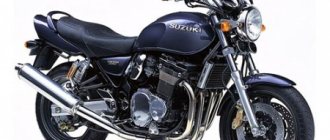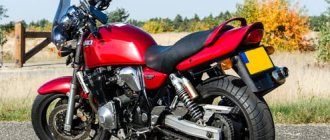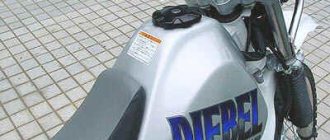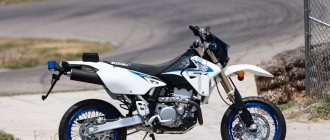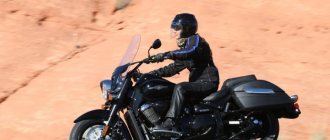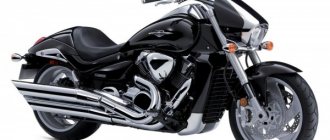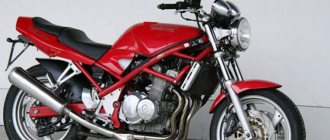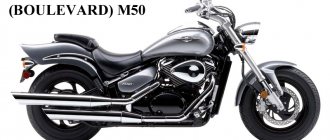Suzuki GSF 250 Bandit motorcycle is a classic road motorcycle from the world-famous Suzuki Bandit series. The style of execution and the rather low price made the motorcycles of this series, especially 250 cc motorcycles, very popular not only among novice motorcyclists, but also among professional racers.
The main reason for the popularity of these motorcycles among people of various professions and types of entertainment is their versatility. Most owners view these bikes as a blank canvas that can be customized to suit any need. Bandit motorcycles can easily be turned into street bikes, dragsters, sports tourers, or serve as road bikes or just for everyday commuting.
Bandits have been produced in various versions over the years in a “naked” form and in variations with the presence of plastic fairings.
The Bandit series motorcycles first rolled off the assembly line in 1989. At the very beginning of their production, only two models were presented on the market: Suzuki GSF 250 and Suzuki GSF 400 (400 cc engine). The Suzuki Bandit 250 was mainly designed for the Japanese domestic market (JDM - Japanese Domestic Market), while the model with a 400 cc engine could be found in many motorcycle markets around the world.
Then, in 1995, Suzuki released models with engines of 600 and 1200 cubic centimeters, but we will dwell in more detail on 250 cubic centimeter motorcycles.
001_MOTO_0310_040
Suzuki Djebel 250 XC, enduro, 1996–2007, 249 cm3, 30/31 hp, 80,000–170,000 rub.
Suzuki Djebel 250 XC, enduro, 1996–2007, 249 cm3, 30/31 hp, 80,000–170,000 rub.
SIMPLE AS A DOCKEL. Djebel means "mountain". Mountains require a thoughtful and serious attitude towards them, as well as good endurance and a reserve of autonomy - all this is present in the design of the “dowel”. Judge for yourself: a huge gas tank for a “check” (17 l), providing a range of up to 400 km, soft long-travel (280 mm) suspensions, not designed for ski jumping, but working perfectly both on asphalt and in full... off-road , not too narrow and not very hard (by the standards of the class!) saddle, large and strong trunk, rear suspension height adjustment (a unique feature among the entire trio). For all its utilitarian-tourist orientation, the “dowel” still remains a 250 cc enduro, capable of jumping from low hills, driving in the snow, and generally having a blast, albeit in an amateur format. In a word, of the whole breed of “chekushki”, perhaps, it is the most universal device.
The Djebel 250 first appeared back in 1992 with the factory designation SJ-44A. (It is easy to recognize by the square headlight yoke.) The first modification was not produced for long and is poorly represented on our market, so we will talk about the widespread SJ-45A. Djebel was intended exclusively for the Japanese market, but this does not promise problems with consumables or spare parts, which are mainly suitable from the “US” analogue of the DR-Z250. The essentials (filters, pads, spark plugs) are always on sale, and the rest can be ordered through electronic stores using branded catalogs. There is also tuning - tanks, steering wheels, protection. Newspapers and the Internet are full of advertisements for the sale of “dowels” of all years of manufacture. The model was discontinued in 2007, so it is impossible to find a completely new motorcycle. When buying a used copy, you should pay attention to the following nuances.
NOT HARMFUL, BUT DIFFICULT. The dowel frame looks monumental, and its strength has been tested by many generations of endurists. Hard use is evidenced by marks on its lower part (at the same time, it wouldn’t hurt to inspect the aluminum parts of the crankcase to see if there are any traces of welding repairs) and a sagging tail - when driving with a heavy load. Minor abrasions don’t count; motorcycle boots wear through the paint over the course of a season. The white color of the frame indicates an early modification, produced before 2000 - with a TM28 carburetor (with an accelerator pump) and the absence of a kickstarter in the base. A later modification - with a black frame, a BSR32 constant vacuum carburetor and - most importantly! - kick in the base. This is a significant plus. It is advisable to choose the option with a trunk - it is expensive separately.
005_MOTO_0310_042
After modernization in 2000, Djebel acquired a constant vacuum carburetor, and a kickstarter became standard.
After modernization in 2000, Djebel acquired a constant vacuum carburetor, and a kickstarter became standard.
The Djebel engine, like many Suzuki air vents, is noisy. When you stop, sometimes you hear a terrible clattering noise - this is also normal, don’t worry. The engine has an automatic decompressor installed, so it will not be possible to measure the actual compression in the cylinder. The only way to check is on the go (of course, if you have enough experience in your arsenal and the owner allows it). In general, the engines run here for a very long time (there is experience of 100–150 thousand km), but they are demanding on the quality of oil and air (the cylinder is nickel-silver). Therefore, keep an eye on the air filter (it is impregnated with foam rubber). And the slightest noticeable leaks at the inlet are a reason to refuse the purchase. Valve clearances are adjusted with washers (they will have to be ordered after measuring the clearances), but the complexity of adjustment is compensated by its relatively rare need (as a rule, this is 20–40 thousand km). By the way, a leaking cylinder head gasket usually indicates that the head has been opened.
Driving performance
The maximum speed indicated in the documentation for the motorcycle was 160 km/h . But the owners say that when the mark is reached, there is a reserve of power for another 20–40 km .
Users note crazy acceleration dynamics, but if you look at the specifications - from 0 to 100 in 8.5 seconds .
Fuel consumption
The consumption is quite high - from 4 liters for off-road use, but considering that the motorcycle is designed only for circuit competitions - it can be called normal. Having a tank of 8 liters , the bike can travel almost 200 km on one fill.
If you consider that this is a sports equipment, and according to traffic rules it should not appear on public roads, then the indicator is more than good .
006_MOTO_0310_042
The oil cooler becomes clogged with dirt flying from the front wheel, but this has almost no effect on engine cooling.
The oil cooler becomes clogged with dirt flying from the front wheel, but this has almost no effect on engine cooling.
The old TM28 carburetor is often criticized for its “low-end failure” and praised for its “sporty top end.” The new BSR32, on the contrary, is “lucky” from the “bottom” and slows down at the “top”. In fact, the old carburetor is not so bad, you just need to correctly adjust the idle speed - and according to the factory recommendation, they are quite high - 1500-1700 (!) rpm. Therefore, if you hear individual flashes when purchasing, do not hesitate to set the “threshing” speed before the trip. With both carburetors, fuel consumption on the highway is within 4–5 l/100 km, i.e. The tank lasts for 300–400 km.
But the most effective means of fighting for traction at the bottom remains “playing” with the stars. The standard 14-42 kit is more or less suitable only for asphalt driving. For light plein air rides mixed with asphalt, the optimal ratio is 13–42, and for hard off-roading and fully loaded outings, we can recommend 13–49—the standard option for the DR-Z250. However, in the latter case, you will need to remake the chain trap. Another bonus for “dowel drivers” is that the drive sprocket is fixed on the gearbox shaft with a simple retaining ring, and not with bolts or a nut, as on most endurics, so replacing it in the field will only require the presence of a retaining ring remover (pliers). The whole operation takes about five minutes, including resetting the chain tension.
You can often hear negative feedback about the operation of the gearbox: it shifts hard, the neutral is difficult to catch... In the vast majority of cases, this is not a design flaw or wear and tear. The “dowel” box is extremely sensitive to the quality of the oil, and its jamming is the first sign that it is time to change the oil. The approximate service life of “synthetics” is 3–5 thousand km, semi-synthetics – up to 3 thousand km. But in hard off-road conditions, of course, you need to do this more often. Another feature of the gearbox is reliable gear locking. It not only allows you to avoid accidental switching while driving (and this is very unpleasant on off-road), but also saves the box itself from overloads. When checking the motorcycle while driving, pay attention to the operation of the speedometer. With the “dowel” it is driven by a cable, which often breaks. But this is not so bad - a modified cable from a VAZ-2107 (70 rubles) is suitable for replacement, but the crumbled gears of the gearbox will require replacement of the assembly. This is a reason for bargaining.
004_MOTO_0310_042
In addition to the usual functions, the trip computer has two resettable odometers with the ability to count down kilometers and a stopwatch with a timer.
In addition to the usual functions, the trip computer has two resettable odometers with the ability to count down kilometers and a stopwatch with a timer.
“Snotty” front fork seals are not a problem, replacing them does not promise problems or special financial costs, you just need to make sure that the working surface of the stays does not have scuffs or severe wear (the fork is very expensive). But a “snotty” rear shock absorber (or, even worse, with traces of corrosion on the rod) is a reason for serious bargaining. Unlike most sports enduros, the “limited” unit is considered non-separable, therefore, repair kits for it are not sold and it can only be replaced entirely and at great cost. Of course, folk craftsmen have recipes for handicraft repair of a unit, but it will not become new - in any case, its service life is no longer the same (a new one can last 30-70 thousand km). The first sign of problems is the appearance of free play in the upper position. Lift the rear of the motorcycle and rock it. Is there any play? This means that gas has escaped from the compensation tank. And a chamber valve embedded in the lid of the tank (for pumping) is a sure sign of disassembly of the unit. The remaining components of the rear suspension do not cause any complaints and can serve for a very long time, incl. due to the presence of grease nipples in each of the four joints (pendulum axis and “progression”).
SMALL JOYS AND SMALL DISGUSTS. An undeniable advantage of the Suzuki Djebel is the ability to adjust the height of the shock absorber. By installing its lower mount in one of two possible positions, you can change the height of the saddle by a couple of centimeters. And if you order an original saddle with a low profile from Japan, the motorcycle will fit even “inches.” The height of the front end can also be changed a little by moving the forks in the traverses. In addition, there are “high” and “low” forks, differing in height (and travel) by about 4 cm. A “high” fork can easily be converted into a “low” one by removing the spacer above the spring rod (to access it, just unscrew the strut plug ).
003_MOTO_0310_042
The second “hole” on the shock absorber allows you to raise and lower the motorcycle a couple of centimeters.
The second “hole” on the shock absorber allows you to raise and lower the motorcycle a couple of centimeters.
But the legendary GPS receiver (on the GPS version) is of no value, at least in Russia. In our open spaces, it can only determine the coordinate, but in Japan, maps are broadcast over a radio channel.
Most devices produced before 2000 are not equipped with a kickstarter. And on swamp hikes it’s simply uncomfortable without it. The cost of a custom kit is about 15 thousand rubles, and you will have to order not only the kick parts, but also the right cover gasket and a modified right footrest.
The twenty-centimeter headlight of the “Dowel” is the calling card of the model. And even if someone considers her an “ugly cyclops”, her light causes unanimous delight - no endurik with a typical “lamp” even came close. And the light bulb there is a common H4, sold in any auto parts store. True, there is a small drawback. On motorcycles of the first years, the headlight was turned on by turning the key in the ignition, which wasted the already modest 4 Ah batteries. Later, a relay appeared that turned on the headlight only after the generator started working (i.e. after an attempt to start the engine).
Perhaps the last nuance that is worth paying attention to is the weak side support spring. Like any road bike, the Djebel is equipped with a “forgetfulness vitamin” - a sensor that interrupts the ignition circuit if the stop is folded down and the gear is engaged. When driving aggressively over bumps, and even more so when jumping, the spring force is not enough to keep the stop in the folded state, and it “plays back” a little. This is enough for the switch to trip. It’s not pleasant when, at the moment of landing after a jump, the engine stalls, even if only for a moment. The choice is small - either install a more powerful spring, or fix the lever with wire or a rubber band before particularly bumpy bumps.
Hi all.
Next is a standard newbie post about the purchase and personal impression of the motorcycle. Preface. A year ago I decided to buy a motorcycle for leisurely country walks with number two. I live in Nicaragua (Central America), there is a huge amount of Chinese and Brazilian motorcycles here. Mostly small-capacity. There was practically no choice, so I bought this Chinese beauty Keeway Suprlight 200:
But he is not the hero of my first post. It quickly became clear that technically the Keeway Superlight 200 is very far from perfect. No, nothing fell off (although I’m lying, I lost the muffler cover once), nothing had to be tightened either, all the bolts were firmly seated (although they were made of some very soft metal and rusted at the touch of a wrench). But it was uncomfortable for me to ride it. It’s strange that I’m talking about the motorcycle in the past tense, since it’s still standing in my yard... In general, the riding experience is strange. As my father said, the motorcycle is “rolly.” Very reluctant to turn. With a full tank, the center of gravity rises greatly. You can't see anything in the mirror. Well, yes, you can replace it, but it’s unpleasant. The chain is stretching and I don’t know what to do about it. After 100 km. It starts rattling when the engine brakes. The power of 15 horses is not enough. They overtake everyone, even 50cc Chinese mopeds with passengers. At a maximum speed of 80-90 km it vibrates quite well. I didn’t attach much importance to this, but my passenger says that it’s a problem. “I don’t want to put my feet on the steps.” The vibrations also cause the wind deflector to rattle. The turn signals are also poorly designed - they turn off only a few seconds after turning them on. Those. You can’t blink, you need to turn it on, wait, turn it off. The left turn button quickly failed. Of the advantages, perhaps, I will note the design. Interesting matte color. Price. I got it for $2,100, and for another $100 I ordered a backrest for the passenger from China.
Let's return to the Suzuki Inazuma. At one point I saw an advertisement and we agreed on a price with the seller. And so it was delivered to my home, by the way, a cool service:
(technical specifications and a lot of photos here) Immediately I went to run it in
My height is 173 cm, so we can say that the motorcycle is not suitable for tall people. Landing with a slightly noticeable tilt forward. The steering wheel is quite low. The mirrors are excellent, they don’t vibrate, everything is clearly visible, and I feel confident on the road. The suspension is moderately firm, there is an adjustable rear monoshock. Haven't climbed there yet.
The 13.5 liter tank lasts a long time. I still can’t detect the consumption, and for now it’s pointless - during the run-in I drove slowly and did not exceed the speed. Now about 1500 km have been covered, maintenance has been done. How much rushing... I only accelerated to 110 so far. The revolutions are about 8 thousand, the ride is comfortable, the engine does not strain and there is a reserve for overtaking. The wind should reach 140 :). My goal was 100 km/h with number two in cruise mode. In our area, cars rarely drive fast; on the highways, everything is mostly calm. There are very few pilots and therefore this speed is quite comfortable and safe.
I like the dashboard.
The photo, of course, sucks... But oh well. Doesn't go blind in the sun! We have hellish sunshine. Everything looks just great. The brakes are nothing special, but they are there. In our heat, always +35 in small traffic jams, it does not overheat, there is an indicator of increased temperature on the tidy. You can select 3 driving modes: eco, sport, norm. I'd like to think they change the engine tuning, but they don't. They just turn on another indicator that signals overspeed. Like, I exceeded 5 thousand in eco mode, the light came on. In short, complete nonsense, fortunately, it can be turned off. There is a clock, 3 odometers. (1 total mileage, 2 routes.)
Cons: 1. The main disadvantage is the weight. 172 kg is a bit much for 250 cubic meters. I watch with envy as people spin their light mopeds around the kickstand in the parking lot. I can't do that yet. I can feel the weight, I can’t push back with my legs as easily as the previous Chinese. By the way, this motor is also assembled in China. I would also consider it a psychological disadvantage. Although it is assembled with very high quality, everything is grown-up. 2. Lots of plastic, definitely expensive to drop. For me it's a minus. Overall the design is not mine at all. I'm more close to real naked kids, but it is what it is. 3. I touch the signal when turning the turn signals on/off. 4. The fuel indicator starts flashing annoyingly when it reaches a quarter of the tank. A quarter of a tank, I still have to go to work for a week. Flashing is annoying, causing you to refuel 
I can't point out more negatives. Overall I like the bike, I really enjoy riding it. I ordered and installed a shad case. In general, there are accessories for motorcycles on the Internet, after keeway it’s unusual. This is the first Japanese brand motorcycle I've ridden. In addition to my former Chinese partner, I rented a lot of different equipment from the Middle Kingdom. Honestly, I was shocked by the sensations after my first trip to Inazuma. From the feeling that you can drive for thousands of kilometers without problems, from the feeling of the integrity of the equipment, nothing rattles, as the gearbox so famously says. I don’t want to start a holivar, but for myself I decided everything unequivocally.
I wrote this post because I heard rumors about deliveries of this motorcycle to Russia. I think that at a normal price it would have found its owners. I made a special effort without those. specifications, personal opinion only.
Hello everyone again, thank you to everyone who read to the end. The result was a 2 in 1 review.
002_MOTO_0310_041
Suzuki Djebel 250 XC.
Suzuki Djebel 250 XC.
BUY "MOUNTAIN". A “dowel” from the first years of production, which has traveled dozens of kilometers across Russia and has changed several owners, but without any special technical problems can be bought for 80–90 thousand rubles; for copies of the last years of production with a range of several thousand kilometers they ask for 150–170 thousand roubles. - this is the ceiling of the price range. Traditionally, the Japanese use “chekushko-enduras” mainly as a means of transportation on roads, and not for conquering off-road terrain, so even ten-year-old vehicles “fresh from Japan” have practically no external defects (except for rust on steel parts from long-term storage in the open air). sky), and the insides, as a rule, are not tortured. The devices “used in Russia” come across very different - from complete “firewood” to completely well-groomed motos. And the price for copies already “registered” in the country in most cases depends more on the technical condition than on the year of manufacture. However, the modernized Djebel, released after 2000, is the best choice today.
and competitors
But the bike did not escape the gaze of competitors. All the other Japanese presented their modifications, although no one could repeat the idea with a built-in navigator.
- Honda offered the XR 250 Baja , on the basis of which they later assembled a motard.
- Kawasaki exhibited the KLR 250 , which, like Honda, has been modified several times. Generations received indexes in the form of letters - from A to D.
- Yamaha supplied the TT250R the TT-R250 Raid for export , creating a certain confusion that did not at all contribute to the popularity of the model
